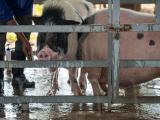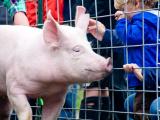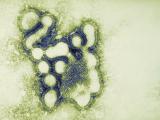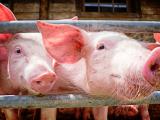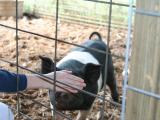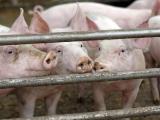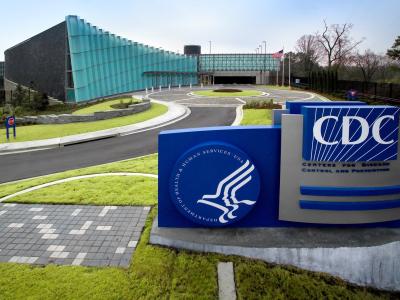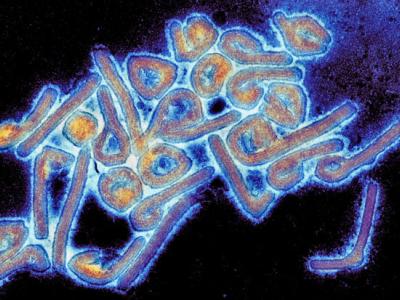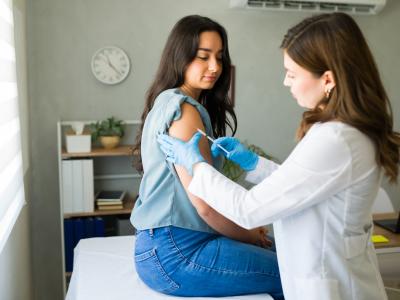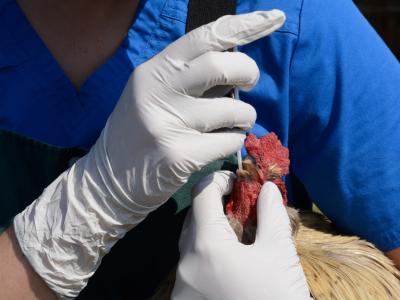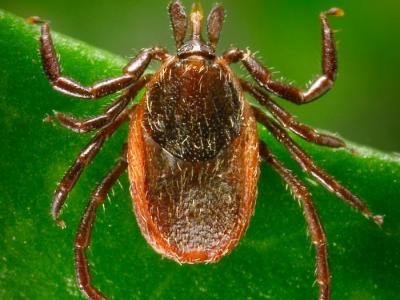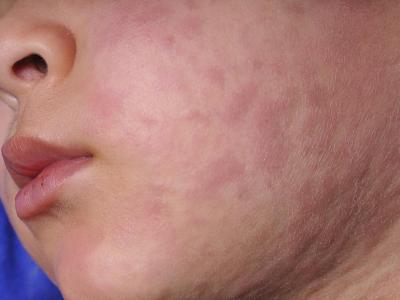Sep 21, 2012 (CIDRAP News) – An investigation of one of the first swine-origin H3N2 influenza cases detected in the United States in 2011 suggests that for each confirmed case, there may be many more that go undetected.
The investigation, triggered by a case related to a Pennsylvania fair in August 2011, revealed 3 confirmed cases, 4 probable cases, and 82 suspected cases of variant H3N2 (H3N2v), all of them in people who had attended the fair, according to a report published yesterday in Emerging Infectious Diseases.
The virus could not be confirmed in most cases because most of those with suspected infections had recovered before the investigation, the report says. But among six children under age 4, an age-group in which retrospective serologic testing for novel flu viruses is more useful than for older groups, four tested positive for antibodies to the virus.
"This finding suggests that illness in at least some suspected case-patients can be attributed to A(H3N2v) virus infection," says the report by investigators from the Centers for Disease Control and Prevention (CDC), the Pennsylvania departments of health and agriculture, and the Allegheny County Health Department in Pittsburgh.
The investigators also found signs that greater exposure to pigs increased the risk of having a suspected case, though this finding was not statistically significant. They found no clear evidence of efficient or sustained human-to-human transmission of the virus.
The three confirmed cases discussed in the report were among 12 that were identified in 2011. So far this year more than 300 cases have been found, nearly all of them over the summer in people who had exposure to pigs at county and state fairs. Also, a few cases of variant H1N2 and one case of variant H1N1 have cropped up recently, also associated with fairs.
All of these variant strains have picked up the M (matrix) gene from the 2009 H1N1 virus.
Casting a wide net
The first infection in the 2011 Pennsylvania cluster was confirmed by the CDC 6 days after the fair closed, and it prompted the CDC and state and local officials to launch a hunt for other cases and possible risk factors, according to the new report.
The investigators cast a wide net to find possible cases. They interviewed swine exhibitors at the fair and members of a national children's agricultural club in the county where the fair occurred. They used the media to encourage people to contact the state health department if they were sick after attending the fair. Also, they encouraged clinicians to obtain samples from patients with flu-like illness after swine or fair exposure.
In addition, the researchers questioned sick contacts of case-patients, and they interviewed visitors at another, later fair in the same county to find out if they had gotten sick after attending the earlier fair. Finally, they used regular flu surveillance to find cases.
The team defined a suspected case-patient as a person who, within 7 days after attending the fair, had one or more flu signs or symptoms from at least two categories, such as fever, respiratory, gastrointestinal, and "constitutional" (fatigue, joint pain). Confirmation of a case was based on reverse-transcriptase polymerase chain reaction (RT-PCR).
Serologic (antibody) testing of suspected case-patients was used to define probable cases. Children age 13 and younger were asked to undergo such testing, because it was assumed they would have little previous exposure to viruses like H3N2v and therefore fewer cross-reactive antibodies, which make results hard to interpret. Previous studies indicated that no children younger than 4 have antibodies to H3N2v, but some children between 4 and 13 have cross-reactive antibodies, the report says.
Consequently, a probable case-patient was defined as a suspected case-patient younger than 4 who had an H3N2v antibody titer over 40. Because of possible cross-reactive antibodies, children between 4 and 13 were considered seronegative if they had an antibody titer under 10 and indeterminate if titers were higher than that.
On this basis, the investigation yielded 3 confirmed, 4 probable, and 82 suspected cases. The three confirmed cases included the initial case and are included in the official total of 12 H3N2v cases the CDC has listed for 2011, said Michael Jhung, MD, a medical epidemiologist in the CDC's Influenza Division and senior author of the study.
Of the 89 total case-patients, 19 (21%) were from households of exhibitors at the original fair, 29 (33%) were from households of ag club members, 4 (4%) had attended both the earlier and the later fair, 34 (38%) had called the state health department to report an illness, 10 (11%) were identified by another case-patient, and 2 (2%) were found through state flu surveillance. Some were identified by more than one method.
Illnesses followed swine exposure
The patients ranged in age from 6 months to 60 years, with a median of 12 years. Most of them got sick within 4 days after the swine show or the swine auction at the fair. The patients spent a median of 6 days at the fair, and 80 of 87 patients with available information reported direct or indirect exposure to swine there.
Of the three confirmed case-patients, one was a girl under age 4 and the others were girls between 4 and 13 years old. One of the latter had a preexisting medical condition and was hospitalized for respiratory distress but recovered, according to the CDC. All seven of the confirmed and probable case-patients attended the swine exhibit at the fair.
Karen Wong, MD, a CDC Epidemic Intelligence Service officer and first author of the study, declined to identify the preexisting condition in the girl who was hospitalized. But she said it was among those that are known to be risk factors for flu complications.
In the serologic investigation, convalescent-phase samples were obtained from 6 of 15 suspected case-patients under 4 years old, and 4 of the 6 were seropositive for H3N2v. Serum samples were gathered from 18 suspected case-patients between ages 4 and 13, four of whom tested negative and 14 of whom had indeterminate results.
One contact of each of four case-patients (3 suspected and 1 confirmed) had flu-like illness, though none had attended the fair within 7 days before their illness. For three of the contacts, respiratory samples were obtained within the first week of illness and tested, and all were negative for flu, though one had a rhinovirus.
The investigators interviewed 127 ag club members, 14 (11%) of whom qualified as suspected case-patients. In this cohort, the risk of having a suspected case increased with the degree of swine exposure: no exposure, 4% risk; visiting swine exhibits, 8%; touching swine, 16%. But wide confidence intervals showed that these findings were not statistically significant.
Few sick pigs
An inspection by a veterinarian on the third day of the fair found no visibly sick pigs, though one had been removed earlier because of a fever, the report says. But in a post-fair survey of swine exhibitors, 8 of 80 households said their swine had shown signs of respiratory illness during or shortly after the fair. All of them had recovered or been slaughtered by the time of the survey. No pigs were tested for flu.
Though flu was not confirmed in any of pigs, the investigation suggests that contact with pigs during the fair was a risk factor for illness, the report says. "Persons reporting direct contact with swine were more likely to report illness," and most patients got sick within 4 days after the swine show or auction.
The report says two findings suggest that at least some of the suspected H3N2v cases were real: 4 of 6 children under age 4 had antibodies to the virus, and suspected case-patients had illness-onset dates and symptoms similar to those of the probable and confirmed patients.
Jhung said it is difficult to say whether the H3N2v cases identified in recent months have been just the tip of the iceberg or if most cases have been detected, thanks to increased awareness and surveillance.
"I think it's reasonable to assume that we have not identified every case that has occurred since July 2012, but it's difficult to tell how many cases may have gone undetected," he told CIDRAP News via e-mail.
"What I can say is that surveillance for variant influenza in the 10 affected states has been enhanced substantially since the first few cases were identified, and that awareness of H3N2v among public health, animal health (and I suspect the general population, due to media reports) is high."
Jhung said in an interview that more recent and ongoing investigations of H3N2v cases by the CDC and state health departments have come up with results generally similar to this one.
"We're finding pretty much the same thing, that there's an association with swine in an agricultural fair setting, which is why we recommend that people at increased risk for complications of influenza avoid swine," he said. "We're also seeing very rare instances of limited human-to-human transmission during the current outbreak. Notably, what we're not seeing is any evidence of efficient or sustained human-to-human transmission."
He commented that there has been "a pretty dramatic decrease" in new H3N2v cases recently, as most county and state fairs have ended. But a few states have fairs scheduled in October and even into November, he said.
Jhung said he thinks official messages reminding people to watch for signs of respiratory illness in pigs have been effective. "I think people are being extremely careful about that and removing pigs that appear to be ill from the fairs," he said.
In this week's flu surveillance update, the CDC reported no new swine-origin variant flu cases, for the first time since the summer outbreak surfaced in July. The number of confirmed H3N2v cases remained at 305.
Wong KK, Greenbaum A, Moll ME, et al. Outbreak of influenza A(H3N2) variant virus infection among attendees of an agricultural fair, Pennsylvania, USA, 2011. Emerg Infect Dis 2012 December (Early online publication) [Full text]
See also:
Sep 2, 2011, CIDRAP News story on first H3N2v cases
Sep 21 CDC flu update
